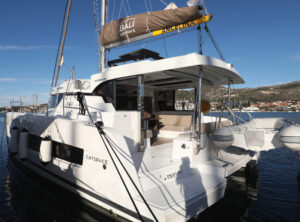
Weather
Home » Weather

Weather
Indeed, navigation in general terms cannot be improvised because it is necessary to be able to take into account the different types of winds that you may encounter along the Adriatic coast and of course to be able to deal with them. There are 4 radio stations where you can get information about the weather conditions: Radio Zagreb, Radio Split, Radio Dubrovnik and Radio Rijeka.
There are also 3 newspaper reports which are also available at the harbor master’s office, marina receptions and charter boat fleets.
The best season for sailing is late spring and early autumn, when temperatures are more moderate, the sea is calm and the winds are more adequate. Before embarking on a catamaran or any other boat, find out about the different types of wind that may occur.
It should be noted that from April to May, showers are occasional with temperatures ranging from 22 degrees Celsius to 28 degrees Celsius. Contrary to June to August where temperatures are much higher ranging from 26 degrees Celsius to 30 degrees Celsius.
There are 3 types of prevailing winds in the Adriatic:
The Bora which is a dry wind, usually blowing from the coast and it is often a sign of good weather. Its strength varies according to the type of relief present but can also go from light to much cooler.
The Sirocco is a wind coming from the southeast but rather hot and humid, blowing along the coast. Of all the winds present in the Adriatic, it is the strongest in the south and occurs at any season.
The Maestral is different because it is a thermal wind that is generated by the heating of the land in relation to the sea. It comes from an inrush of air complemented by sea air.
There are ideal winds for sailing:
Burin: which is a wind that blows mainly in summer and especially at night.
Jugo-Ostro: which blows mainly at the end of the month of September.
As well as more dangerous winds:
Lebic and Pulenat: are winds that blow very rarely but can become very dangerous because they are fast and very strong.
Jugo-Siroko: is one of the most dangerous because it is a wind accompanied by rain and can blow for almost 3 consecutive days. It causes a rise in the sea level.
Nevera: is the most dangerous, it announces its presence by heavy clouds, lightning but also strong thunderstorms and rain and can last for hours without stopping.
It is important to know that the tides are located in the Adriatic Sea and in general do not affect the safety of
do not affect the safety of navigation.
The sea currents do not pose any problems for navigation either.
We must take into account that there are also cyclones that affect navigation in the Adriatic Sea. And these are heading west and east.
Weather conditions in Croatia can be unpredictable at times. That is why it is important to check the weather conditions and forecast before your cruise.
Cyclones are really rare in summer and usually pass more to the north. During certain hot periods, cyclones can become more numerous and even more dangerous and can cause small shifts in the seasons.
In addition, we advise you to prepare your navigation in a very particular way, to stay always awake so as not to have any surprise during your cruise.
Think of establishing an itinerary adapted to the winds that you may encounter, this will optimize your cruise and you will be able to fully enjoy being prepared for any eventuality.
You have several tools at hand to help you in your research on the weather forecast. You can get information on Windy which is an application proposing all kinds of data related to the weather, it is free and proposes you forecasts for about ten days, perfect if you opt for a week long cruise.
In conclusion, you can now leave well informed in the Adriatic Sea but always remember to prepare yourself by preparing the necessary to face all the unexpected moments and all this will also give you some experience if you have never sailed in strong winds. So always keep your senses alert.
Quick Links


BALI CATSPACE – 4 FRIENDS – 2022

LAGOON 42 – 4 + 2 CAB. – MEDIA LUNA – 2019.

Croatia itinerary 7 days

Itinerary for a 14-day yacht charter from the Split region





